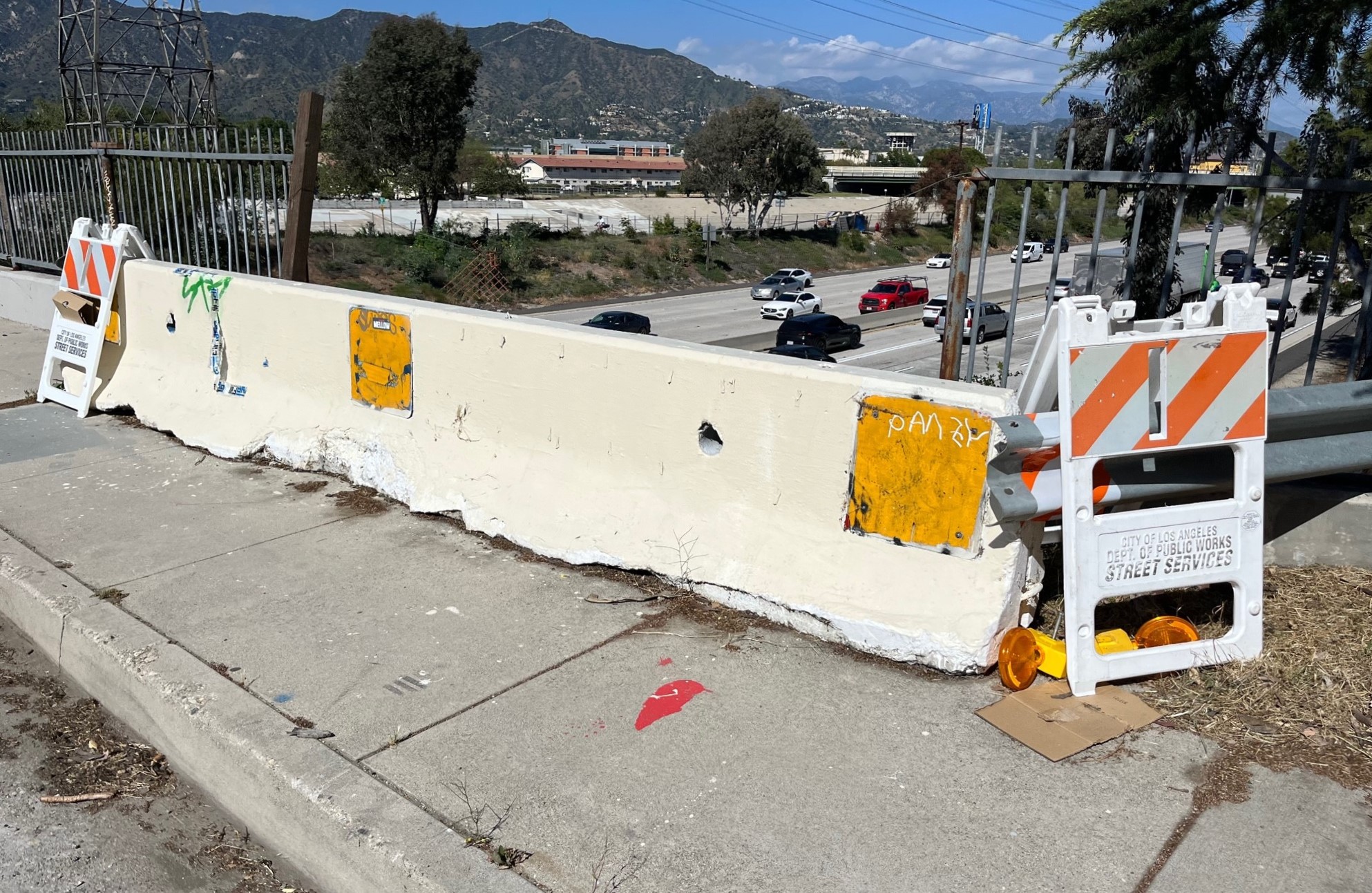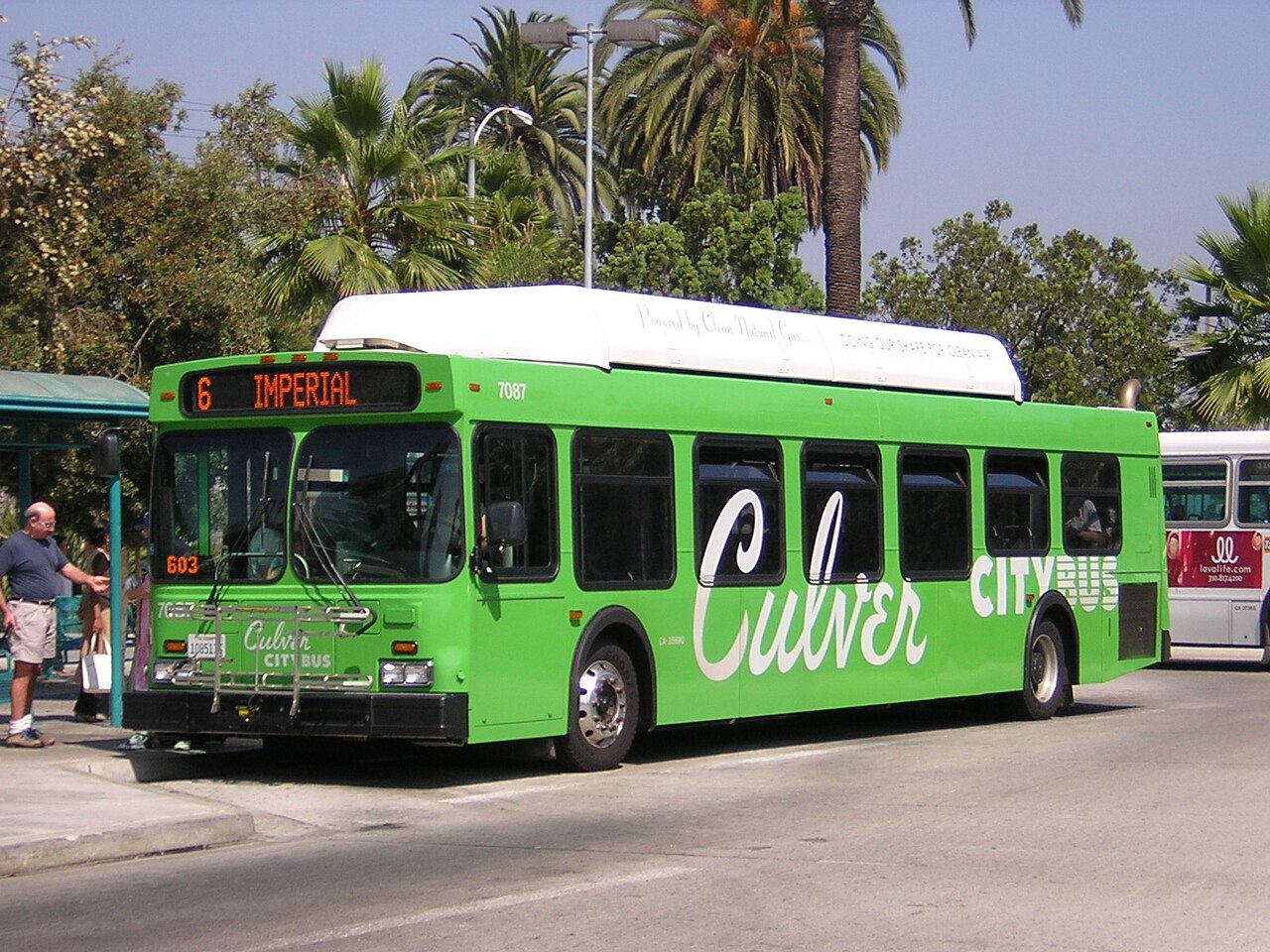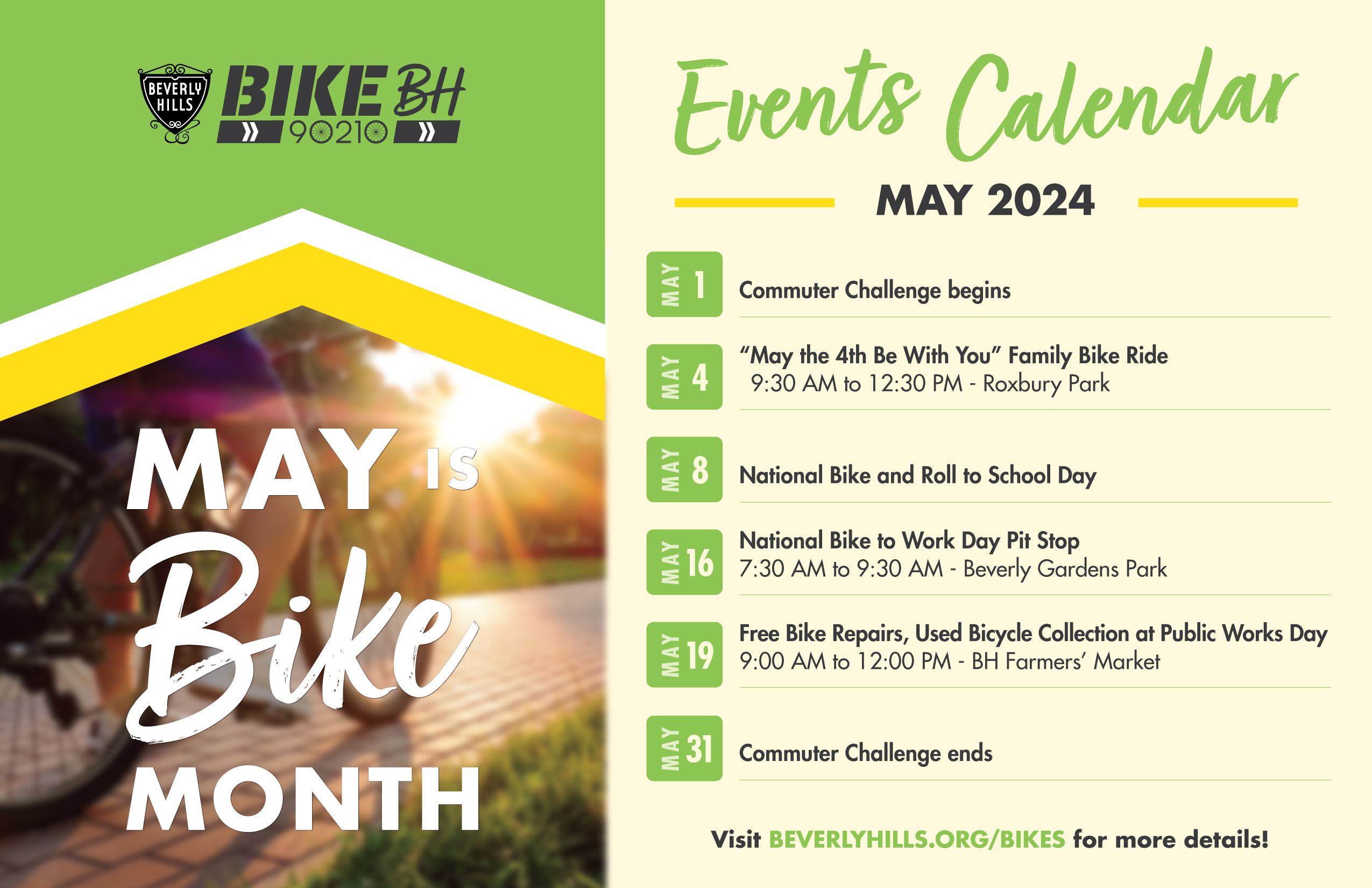L.A. City Bikeway Mileage Increased in Fiscal Year 2019-20, but Network Still Lacking
1:30 PM PDT on September 2, 2020
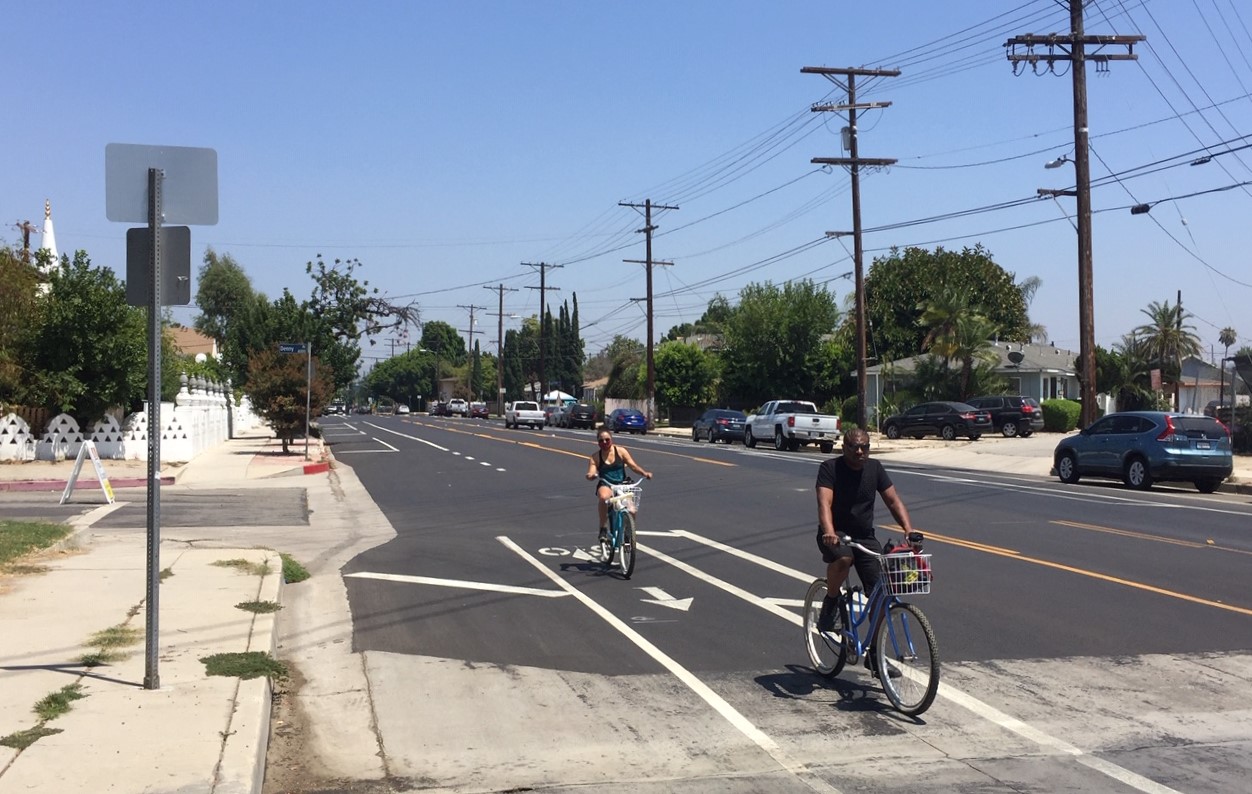
New road diet bike lanes on Oxnard Street in North Hollywood. All photos by Joe Linton/Streetsblog L.A. – except where indicated otherwise
Typically at the end of each fiscal year, the L.A. City Department of Transportation publishes an annual report. In the past, the report included the number of miles of bike facilities completed. The LADOT annual report is delayed, but LADOT provided Streetsblog a spreadsheet of the department's Fiscal Year 2019-20 bikeway implementation.
About a decade ago, under Mayor Antonio Villaraigosa, annual LADOT new bikeway output peaked at more than 200 new bikeway lane-miles. Since Mayor Eric Garcetti took office in 2013, bikeway mileage implementation has fallen dramatically. Early on, Garcetti-appointed LADOT General Manager Seleta Reynolds' approach suggested that her department would be focused on bikeway quality over quantity. A quality protected bike lane is more worthwhile than a sharrow-ed bike route. Though Reynolds' LADOT was responsible for the city's first protected bike lanes, mostly her tenure has meant a huge drop off in new bikeway mileage, essentially freezing L.A.'s long-inadequate network in place. Protected bike lanes remain rare outside of downtown L.A.
From day one, Reynolds was hampered by many City Councilmembers - Gil Cedillo, Paul Koretz, Curren Price, David Ryu - who already openly opposed bikeways in their districts. After a 2017 backlash against ambitious safety improvements in Playa Del Rey, much of the rest of the council became reluctant to implement bike facilities that would remove lanes or parking spaces from drivers. Soon after, more centrist councilmembers - Mitch O’Farrell, Paul Krekorian - canceled bike safety projects in their districts.
That dismal situation largely remains the case today.
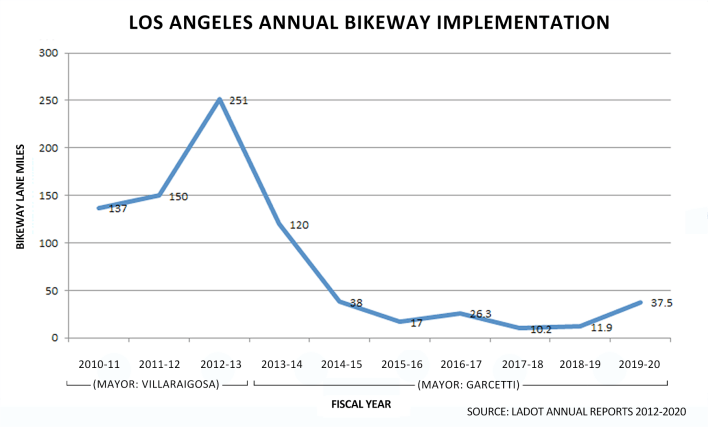
The good news is that overall bikeway implementation improved significantly in the past year.
For the prior two fiscal years, LADOT new bikeway mileage was dismal. FY17-18 saw only 10.2 bikeway miles. FY18-19 saw 11.9 miles. For Fiscal Year 2019-20, LADOT reports installing 37.5 miles of new and upgraded bikeways.
(LADOT's spreadsheet and web page list claim 50.9 miles, but these include two facilities - Avalon Boulevard and Olive Street - where installation work was still underway but not quite completed by July 1, so the above graph uses an adjusted LADOT total of 37.5 miles. See line by line details at Streetsblog L.A.'s full corrected LADOT FY19-20 bikeway mileage Google spreadsheet. Note that, due to corrected lengths, some SBLA totals do not equal LADOT totals.)
There is distinction to be made regarding new bikeway mileage compared to upgrades to existing bikeways.
Some upgrades - e.g. converting 7th Street bike lanes from conventional to protected - are worthwhile, while many - e.g. upgrading existing Tampa Avenue conventional bike lanes to buffered bike lanes - only marginally improve existing conditions. Upgrades are needed, but they do not extend the bikeway network. In many cases, LADOT bikeway upgrades point to the city's failure to install the safest and best improvements at the outset. Why didn't Forest Lawn Drive bike lanes have a buffer when they were initially installed around a decade ago? Also, many upgrades allow the city to double- and triple-count mileage on a street as it first gets, say, sharrows, then a bike lane, then a buffered bike lane, then a protected bike lane.
Of the total 37.5 miles LADOT reported, SBLA totals 36.7 actual miles, with 18.5 miles of new bikeways and 18.2 miles of upgrades to already existing bikeways. Last year there were 4.7 new lane-miles and 8.3 miles of upgrades.
There is a lot of variation in what LADOT is claiming as new bikeways. Some facilities - e.g. adding two-way travel to downtown L.A.'s Main Street protected bikeway - are excellent. Other facilities, such as the sharrows on Tujunga Avenue, are hardly an upgrade over existing conditions. LADOT is claiming new "bike-friendly streets" (aka bike boulevards) on Hatteras Street and Prosser Avenue, which have just sharrows and speed bumps. Better than nothing, but hardly bike-friendly.
So, a more telling report might to look at two primary measurements:
- New Lane Miles - new bike lanes (conventional, buffered, or protected) and paths. Not including merely sharrow-ed or signed bike routes. These new lanes expand the city's bikeway network.
- Significant Upgrades - conventional or buffered bike lanes upgraded to protected lanes - and one-way protected lanes converted to two-way protected lanes. Not including buffers added to existing bike lanes. (What can be a grey area here is that some projects are only partially-protected - such as just one block or one side of the street. For SBLA's listing of all L.A. City protected lanes, facilities with shorter than a quarter mile of protection were omitted.)
FY19-20 saw 11.3 miles of new bike lanes. Existing bike lanes upgraded to protected lanes accounted for 8.7 miles overall, though a couple of these (parts of Winnetka and Vineland Avenues) are very short stretches so the significant upgrades total just over 8 miles.
Any way one measures it, ~37 total miles (with ~20 quality miles) represent a significant increase over recent dismal ten-to-twelve mile totals - though overall bikeway mileage installation still remains relatively low.
What accounts for the increase? There does not appear to be a single reason, but one factor that appears to have helped increase mileage is stepped-up street repaving, thanks to the Bureau of Street Services - now called 'Streets L.A.' Whether there is a bike lane or not, bicycling on these newly resurfaced streets is much safer and more comfortable than the worn surfaces that were there before.
In 2017, the city paid out nearly 20 million dollars to settle lawsuits from solo bicyclist crashes blamed on poor pavement conditions. In response to these payments, the City Council passed two motions that improved inspecting and maintaining city bikeways. For the past year, Streets L.A. repaved plenty of bikeway streets, many of which received upgrades (in addition to great smooth asphalt.) Places where LADOT initially implemented a conventional bike lane were now deemed wide enough to squeeze in a buffer and/or some bollard protection.
In the last couple years, Streets L.A. has been proactively targeting repaving many streets where bicycle crashes (especially lawsuits, deaths, and serious injuries) have taken place. FY19-20 bikeway upgrades include resurfaced and newly buffered bike lanes on the portion of Reseda Boulevard where the city paid out $7.5 million in 2017 in cyclist William Yao's solo crash lawsuit.
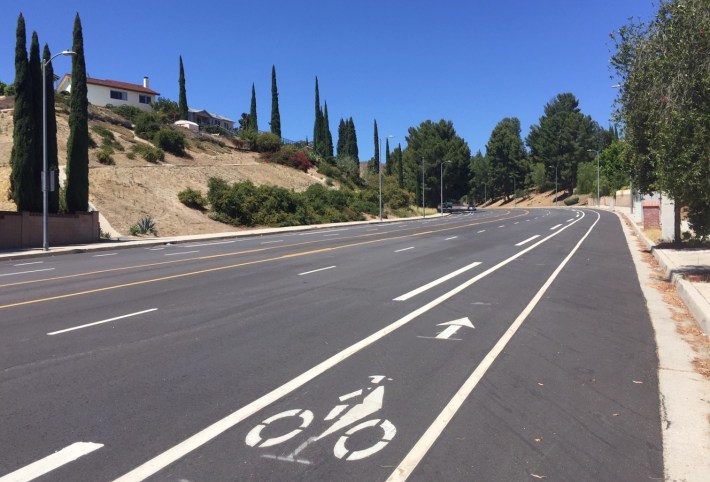
Two short new stretches of bike lanes were added to Griffith Park Boulevard, an aging concrete street where the city settled two cyclist solo crash lawsuits totalling $700,000. One of those stretches of Griffith Park Blvd, north of Los Feliz Boulevard, was the site of the 2019 car vs. cyclist crash death of Jeff Jones. The Los Feliz Neighborhood Council advocated for resurfacing and adding the new bike lane there.
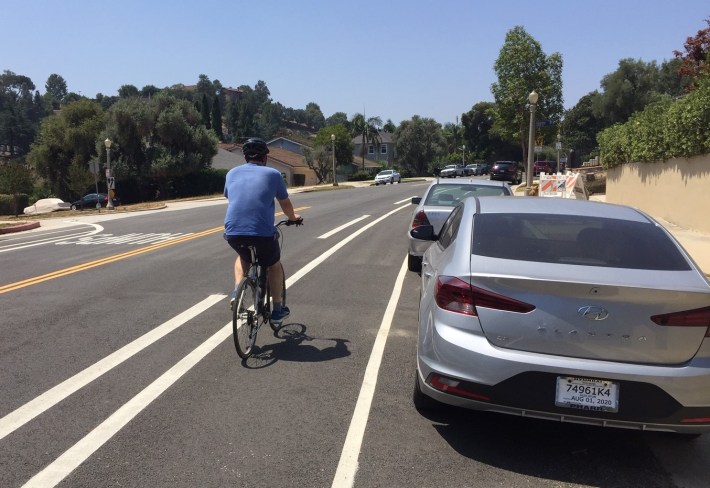
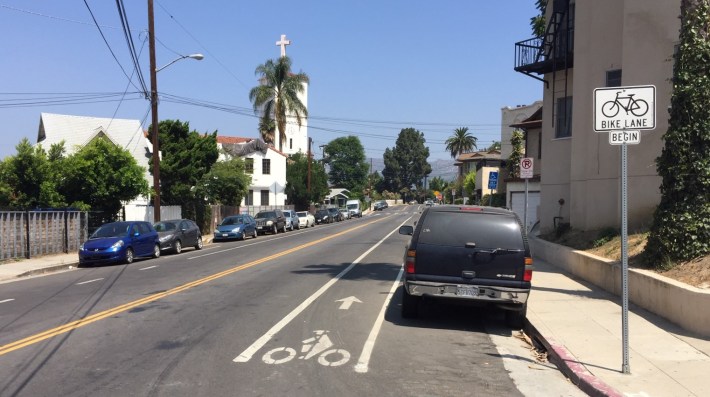
Under COVID-19, Streets L.A. has backed off of repaving smaller residential streets and stepped up repaving on bigger streets, under its ADAPT program. Bike lanes tend to be located on these bigger streets, so ADAPT repaving has resulted in upgrades. There have been a few missed opportunities (more on those in a future post) but, by and large, more repaved arterials has meant more miles of conventional, buffered, and protected bike lanes, especially on the relatively wide streets in the San Fernando Valley.
In addition to the facilities mentioned/pictured above, below is a run-down of some additional FY19-20 bikeways.
The Good
In downtown Los Angeles - one of the most biked and bikeable places in the city, LADOT completed a couple of great protected lane facilities. One-way buffered bike lanes on Main Street were upgraded to an excellent two-way protected bikeway about a mile and a half long. The very useful 7th Street bike lanes were upgraded to protected.
Stretches of protected bike lane were installed in less-heavily biked areas outside of downtown, especially in the east San Fernando Valley. These include parts of Woodman Avenue (a very useful central Valley bike north-south corridor) in Panorama City, as well as too-short portions of Clybourne Avenue and Vineland Avenue in North Hollywood. New protected bike lanes on Anaheim Street in Harbor City make some useful connections, but stop short of going under the 110 Freeway to connect to Wilmington's bikeway network.
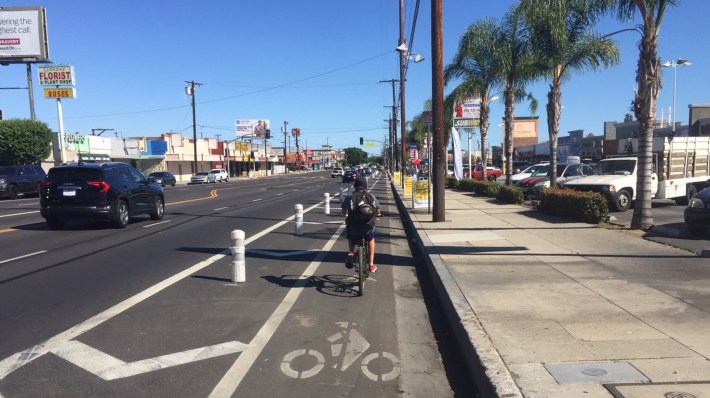
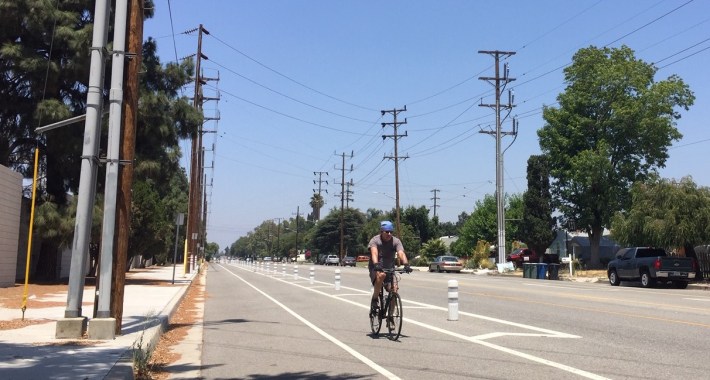

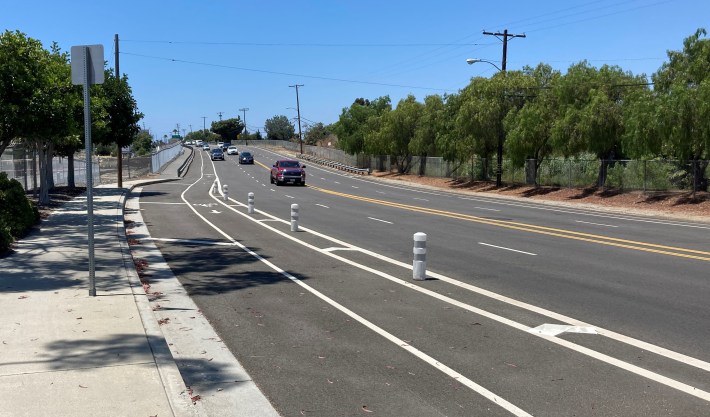
Bike lanes were added to Oxnard Street (see top photo) as part of a very pleasant low-key half-mile long road diet - between Vineland Avenue and Cahuenga Boulevard in North Hollywood.
Especially in the Valley, many facilities extended existing bikeways, some closing network gaps. Winnetka Avenue, Burbank Boulevard, Woodley Avenue and Riverside Drive bike lanes were extended smartly with new mileage.
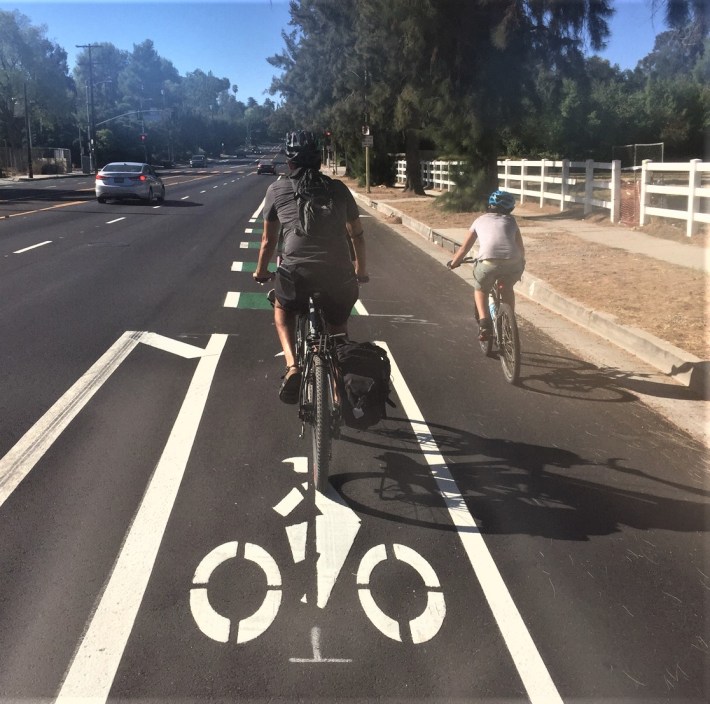

Eagle Rock's York Boulevard bike lane extended the relatively strong NELA bikeway network. New bike lanes on 19th Street (in San Pedro) and on Santa Monica Boulevard (in Century City next to Beverly Hills' new green bike lanes) also closed gaps.
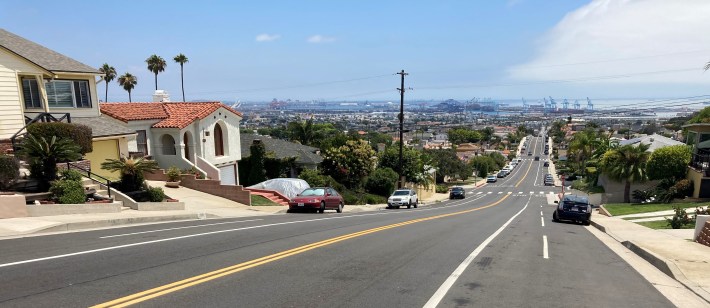
Worthwhile but less useful extensions included short extensions of existing bike lanes on Strathern Street and Tampa Avenue.
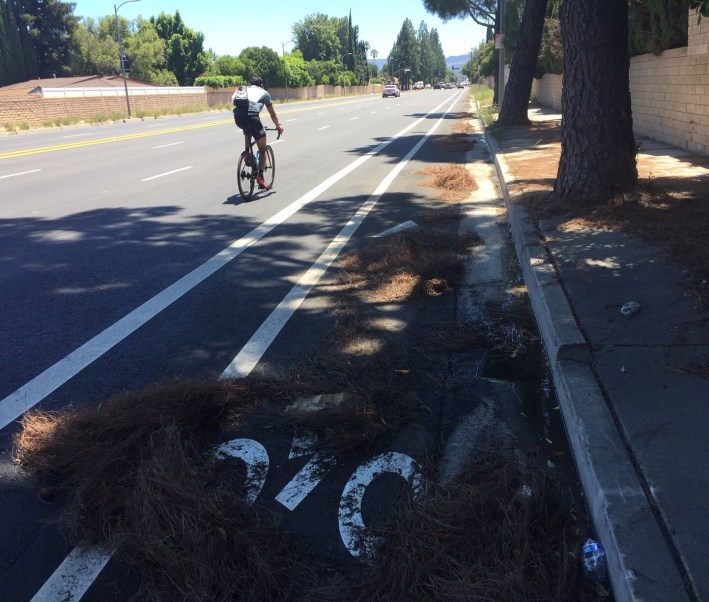
Lastly, they did not contribute a lot of mileage, but the city opened two new bike bridges over the L.A. River - in North Atwater and Atwater Village. These connect new neighborhoods to the growing L.A. River bike path.
The Meh
There were lots of new buffers added to existing bike lanes, a minor upgrade that does help improve safety just a bit. New buffers on portions of Forest Lawn Drive, Reseda Boulevard, Silver Lake Boulevard, Tampa Avenue, and Van Nuys Boulevard are unlikely to make any new riders feel safe enough to use these streets.
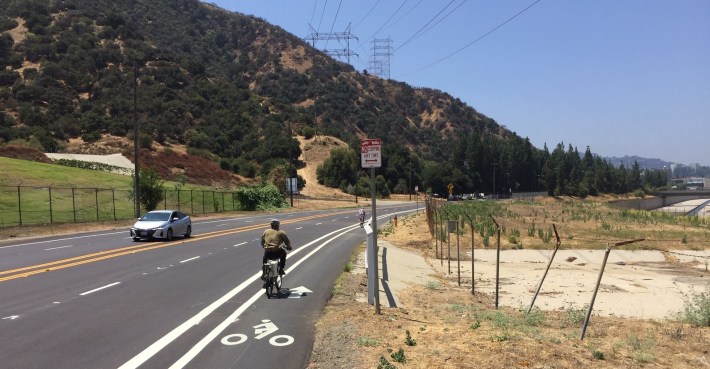
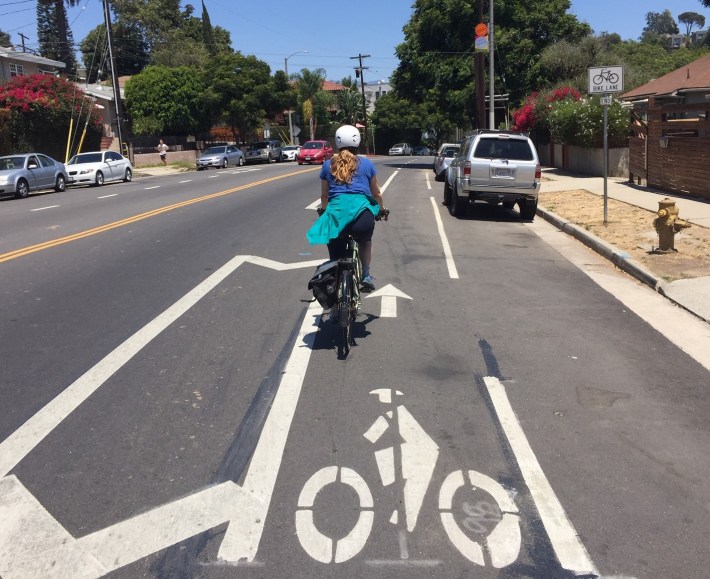
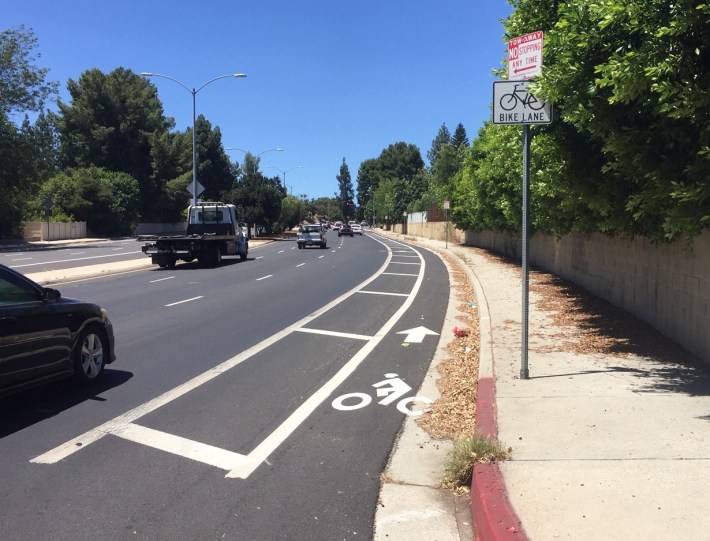
An oddball sidewalk bikeway was converted to a conventional bike lane on Ohio Avenue in West L.A.
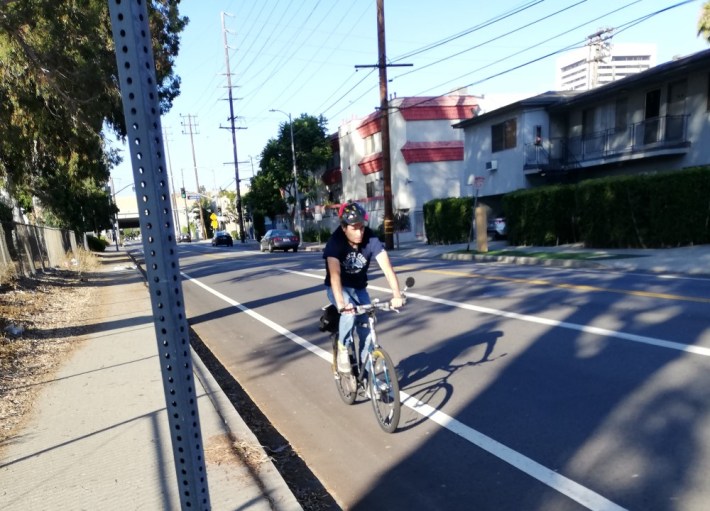
The Bad
Sharrows should be facility of last resort, generally for things like short gaps where there is not space for a real bike facility (more or less what LADOT did on York this year.) New sharrows on Foothill Place, Hatteras Street, Possner Street, and Tujunga Avenue will do little to make bicyclists safe or comfortable. They are arguably hardly worth the cost of the paint.

Good News for the Next Fiscal Year
LADOT and Streets L.A. have already completed quite a few very worthwhile bike facilities in the first two months of Fiscal Year 2020-21. South L.A.'s 6.3-miles long new Avalon Boulevard bike lanes are among the longest in the city. The new fiscal year has also seen new protected bike lanes on Olive Street, Grand Avenue, 5th Street, 6th Street, Broadway, and Eldridge Avenue.
Thank you to Chase Engelhardt, Michael MacDonald, Zachary Rynew, David Shelton, and Don Ward for research assistance on this post.
Stay in touch
Sign up for our free newsletter
More from Streetsblog Los Angeles
LAPD Was Crossing Against Red Light in Crash that Killed Pedestrian and Injured Six in Hollywood
The department says the officers had turned on their lights and sirens just before crossing. Their reasons for doing so remain unknown.
Freeway Drivers Keep Slamming into Bridge Railing in Griffith Park
Drivers keep smashing the Riverside Drive Bridge railing - plus a few other Griffith Park bike/walk updates
This Week In Livable Streets
Bike Month, Hyperion street safety, Eastside rail plans, Pasadena transit, CicloIRVINE, Culver City bus service, and more


